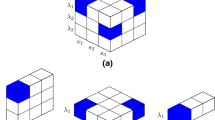Abstract
We present new families of three-dimensional (3-D) optical orthogonal codes for applications to optical code-division multiple access (OCDMA) networks. The families are based in the extended rational cycle used for the 2-D Moreno-Maric construction. The new families are asymptotically optimal with respect to the Johnson bound.


Similar content being viewed by others
References
Ortiz-Ubarri, J., Moreno, O., Tirkel, A.: Three-dimensional periodic optical orthogonal code for OCDMA systems. In: Information Theory Workshop (ITW), 2011 IEEE, pp. 170–174. IEEE (2011)
Moreno, O., Maric, S.V.: A new family of frequency-hop codes. IEEE Trans. Commun. 48(8), 1241–1244 (2000)
Moreno, O., Zhang, Z., Vijay Kumar, P., Zinoviev, V.A.: New constructions of optimal cyclically permutable constant weight codes. IEEE Trans. Inf. Theory 41 (2), 448–455 (1995)
Tirkel, A., Hall, T.: New matrices with good auto and cross-correlation. IEICE Transactions on fundamentals of electronics, Communications and Computer Sciences 89(9), 2315–2321 (2006)
Gomez-Perez, D., Gomez, A.-I., Tirkel, A.: Arrays composed from the extended rational cycle. Advances in Mathematics of Communications 11(2), 313–327 (2017)
Omrani, R., Garg, G., Vijay Kumar, P., Elia, P., Bhambhani, P.: Large families of asymptotically optimal two-dimensional optical orthogonal codes. IEEE Trans. Inf. Theory 58(2), 1163–1185 (2012)
Kim, S., Yu, K., Park, N.: A new family of space/wavelength/time spread three-dimensional optical code for OCDMA networks. J. Lightwave Technol. 18(4), 502–511 (2000)
Shum, K.W.: Optimal three-dimensional optical orthogonal codes of weight three. Des. Codes Crypt. 75(1), 109–126 (2015)
Li, X., Fan, P., Shum, K.W.: Construction of space/wavelength/time spread optical code with large family size. IEEE Commun. Lett. 16(6), 893–896 (2012)
Alderson, T.L.: 3-Dimensional Optical Orthogonal Codes with Ideal Autocorrelation-Bounds and Optimal Constructions. IEEE Trans. Inf. Theory 64(6), 4392–4398 (2018)
Chung, F.R.K., Salehi, J.A., Wei, V.K.: Optical orthogonal codes: design, analysis and applications. IEEE Trans. Inf. theor. 35(3), 595–604 (1989)
Park, E., Mendez, A.J., Garmire, E.M.: Temporal/spatial optical CDMA networks-design, demonstration, and comparison with temporal networks. IEEE Photon. Technol. Lett. 4(10), 1160–1162 (1992)
Mendez, A.J., Gagliardi, R.M.: Code Division Multiple Access (CDMA) Enhancement of Wavelength Division Multiplexing (WDM) Systems. In: Communications, 1995. ICC’95 Seattle,’Gateway to Globalization’, 1995 IEEE International Conference on, vol. 1, pp. 271–276. IEEE (1995)
Moreno, O., Ortiz-Ubarri, J.: Group permutable constant weight codes. In: Information Theory Workshop (ITW), 2010 IEEE, pp. 1–5, Dublin, Ireland, September 2010, IEEE
Alderson, T.L., Mellinger, K.E.: Spreads, arcs, and multiple wavelength codes. Discrete Math. 311(13), 1187–1196 (2011)
McGeehan, J.E., Motaghian Nezam, S.M.R., Saghari, P., Izadpanah, T.H., Willner, A.E., Omrani, R, Kumar, P.V.: 3D Time-Wavelength-Polarization OCDMA Coding for Increasing the Number of Users in OCDMA LANs. In: Optical Fiber Communication Conference, 2004. OFC 2004, Vol. 2, pp. 3–Pp. IEEE (2004)
Johnson, S.: A new upper bound for error-correcting codes. IRE Trans. Inf. Theor. 8(3), 203–207 (1962)
Berlekamp, E., Moreno, O.: Extended double-error-correcting binary goppa codes are cyclic (corresp). IEEE Trans. Inf. Theor. 19(6), 817–818 (1973)
Singh, J., Singh, M.L.: A new family of 3-D optical orthogonal codes for optical CDMA systems with differential detection. J. Opt. Fiber Commun. Res. 6(1), 11–21 (2009)
Acknowledgments
This work was partially supported by the National Science Foundation under Grant No. 1438838.
Author information
Authors and Affiliations
Corresponding author
Additional information
Publisher’s note
Springer Nature remains neutral with regard to jurisdictional claims in published maps and institutional affiliations.
Rights and permissions
About this article
Cite this article
Ortiz-Ubarri, J. New asymptotically optimal three-dimensional wave-length/space/time optical orthogonal codes for OCDMA systems. Cryptogr. Commun. 12, 785–794 (2020). https://doi.org/10.1007/s12095-019-00422-1
Received:
Accepted:
Published:
Issue Date:
DOI: https://doi.org/10.1007/s12095-019-00422-1
Keywords
- Periodic arrays
- 3-D OOC
- Optical orthogonal codes
- Digital watermarking
- Radar
- Sonar
- Frequency hopping
- Constant weight codes



